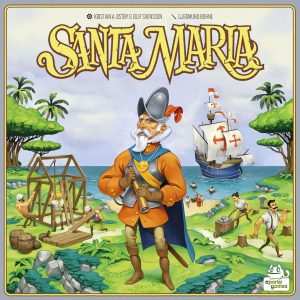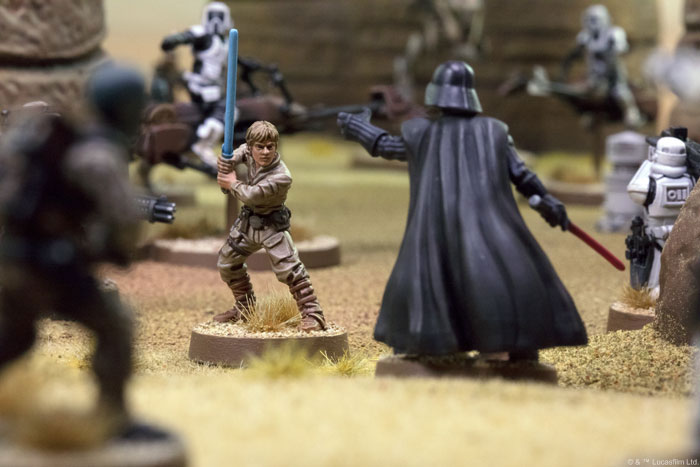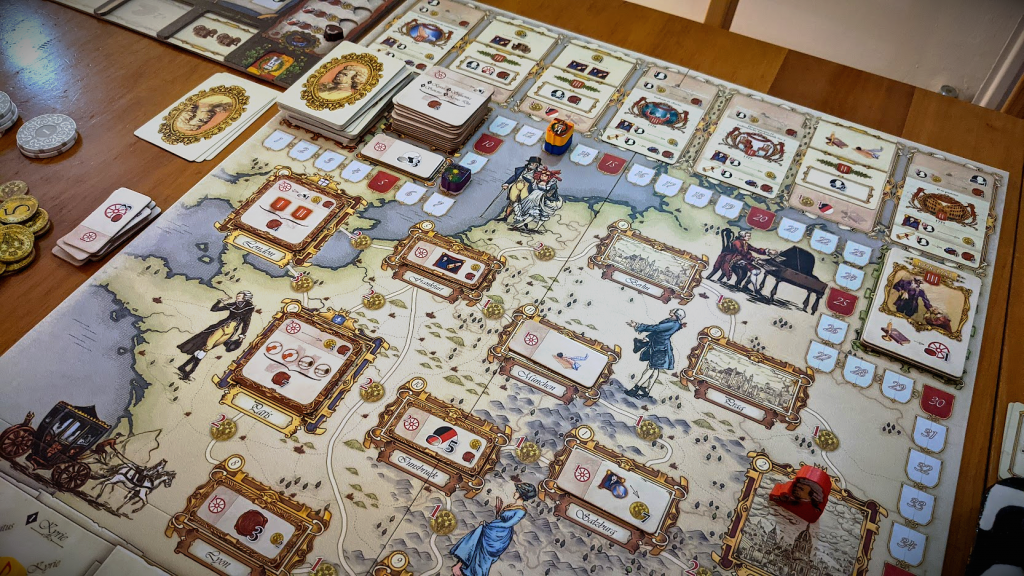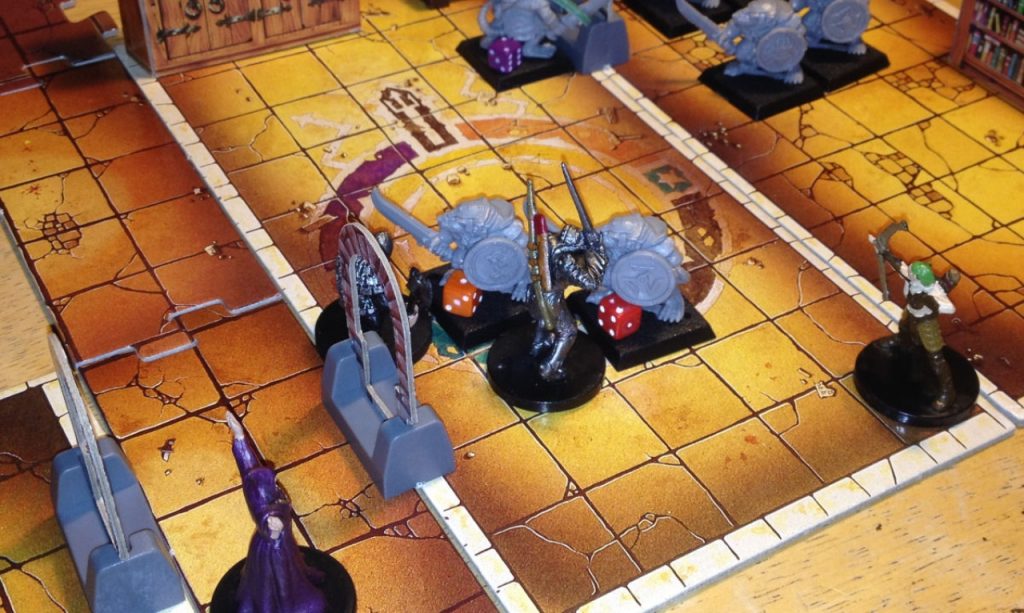Quinns: There’s quite a bit of buzz around Santa Maria. “Buzz!” spake this box as it arrived in my flat like a gentle but hefty bumblebee, excited to alight on my table.
Paul: OH GOD WHERE’S THE SPRAY QUICK OPEN A WINDO-
Quinns: It’s fiiiine Paul! This is something we can safely let into our homes to flit happily about, to land on our tables or to watch us from the shelves with its compound eyes. Santa Maria is quite harmless!
Paul: Harmless and… perhaps toothless?
Popping open the almost cartoonishly cute box, which appears to depict Santa Claus as armoured as he is jolly, we’ve got dice! We’ve got charming wooden tokens! We’ve got wonky jungle tiles! We’ve got… is this the terrifying face of an inflated baby, about to burst?!
Oh, don’t worry. That’s just the universal symbol for happiness! Happiness is the currency that can make you, dear player, the winner, if you can just amass enough of it inside your Happiness House.
Quinns: While we were playing I took a different tack, imagining that this was the house where I kept all of my creepy, spherical, pale babies.
ANYWAY, here’s how the game works.
Each player in Santa Maria is given their own little Spanish colony in South America, one of which you can see above. After a game lasting a snappy sixty minutes, the winner will be whoever managed to wring the most Orwellian Happiness Points out of this tricky 6×6 grid.
On your turn you MIGHT spend resources adding tiles that extend your colony, like so:

Or you might spend your turn dropping one of that round’s available dice into your colony, as if you were dropping awkward balls into a pinball table, which is how you get resources.
Let’s say you drop in a white 3, as seen below. This die enters via the “3” column, and will grant you the reward of every space it passes over – so you might get WOOD, then a GEM, then MONEY, then TWO ROTUND HAPPINESS BABY-POINTS – before that die finally comes to a stop in the last action space it used, blocking it for the rest of the round. If a particular row or column is good enough, you might even slide multiple dice over it- and you often can, since you can pay coins to increase or decrease the number of pips on your dice.
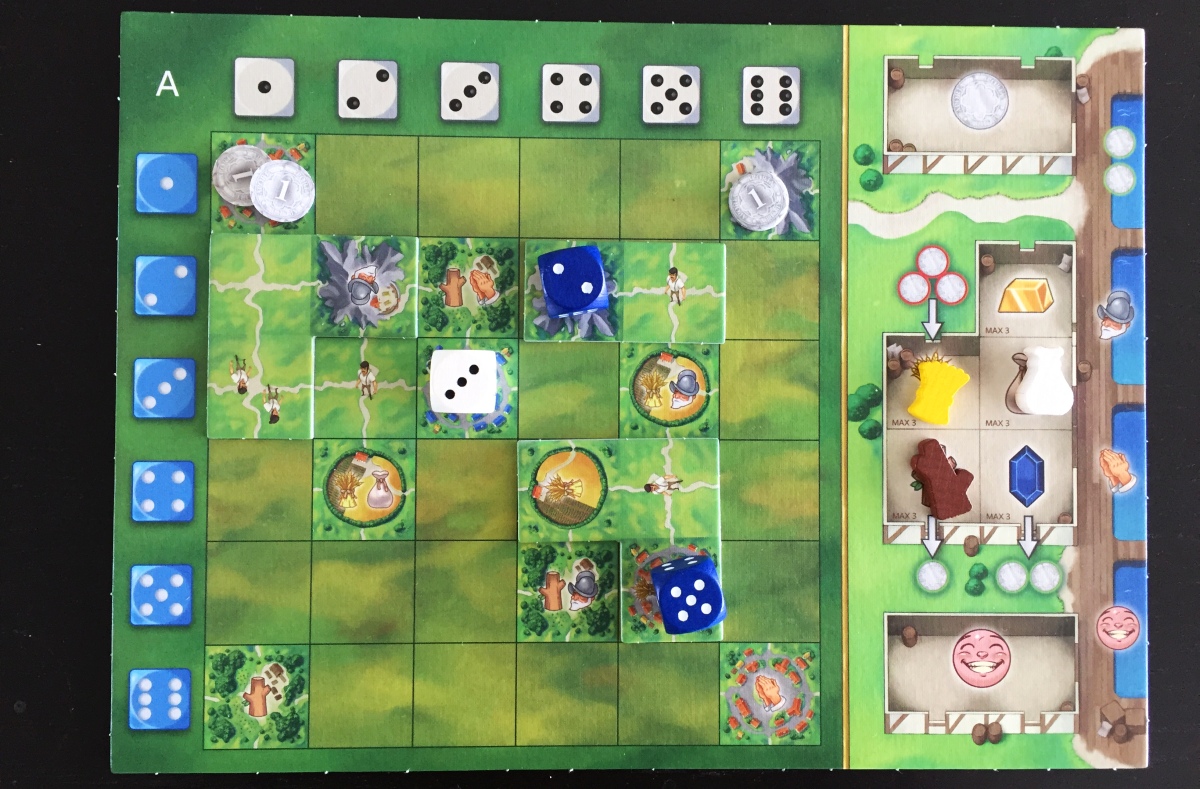
Players can also simply pave over a square with coins to get its reward, but these coins similarly block your machinery until the end of the round. Since Santa Maria ends after just 3 rounds, you want to be very canny about this. With a bit of caution and wit, you might acquire a fabulous new tile and get the reward for it once, twice, three times, FOUR TIMES. You’re a monster! Won’t somebody stop you?
Paul: Now, let me immediately tell you that watching your die carve its way through the jungle like a missionary with a machete is slicingly satisfying. You trigger all those resource bonuses as if you were running past a row of fireworks with a burning torch in your hand, your beaming face turned to the heavens, ready to be showered by an explosion of gems and money and lumber.
What’s even more satisfying is squeezing new tiles onto your player board, arranging your colony to create rows and columns that you know are going to burst like bountiful pimples as your die trundles over them. You made that combination yourself, you set up and then tripped each of them so expertly. You’re the master of your own destiny!
The pleasure comes from solving two puzzles of your own making. The first was how to align all those disparate colony pieces into rows that would most efficiently and most cannily bear fruit, the second was working out the best order to claim and use dice. Sometimes it’s best to first send a blue die trundling from left to right, claiming a whole row of resources and only blocking something at the end of your 6 column, other times you’ll want to send white dice trickling down columns to stop exactly where you know they’re not going to interrupt any future moves. And each turn, with new die rolls producing new possibilities, this second puzzle always reconfigures itself, even if you don’t add to your colony.
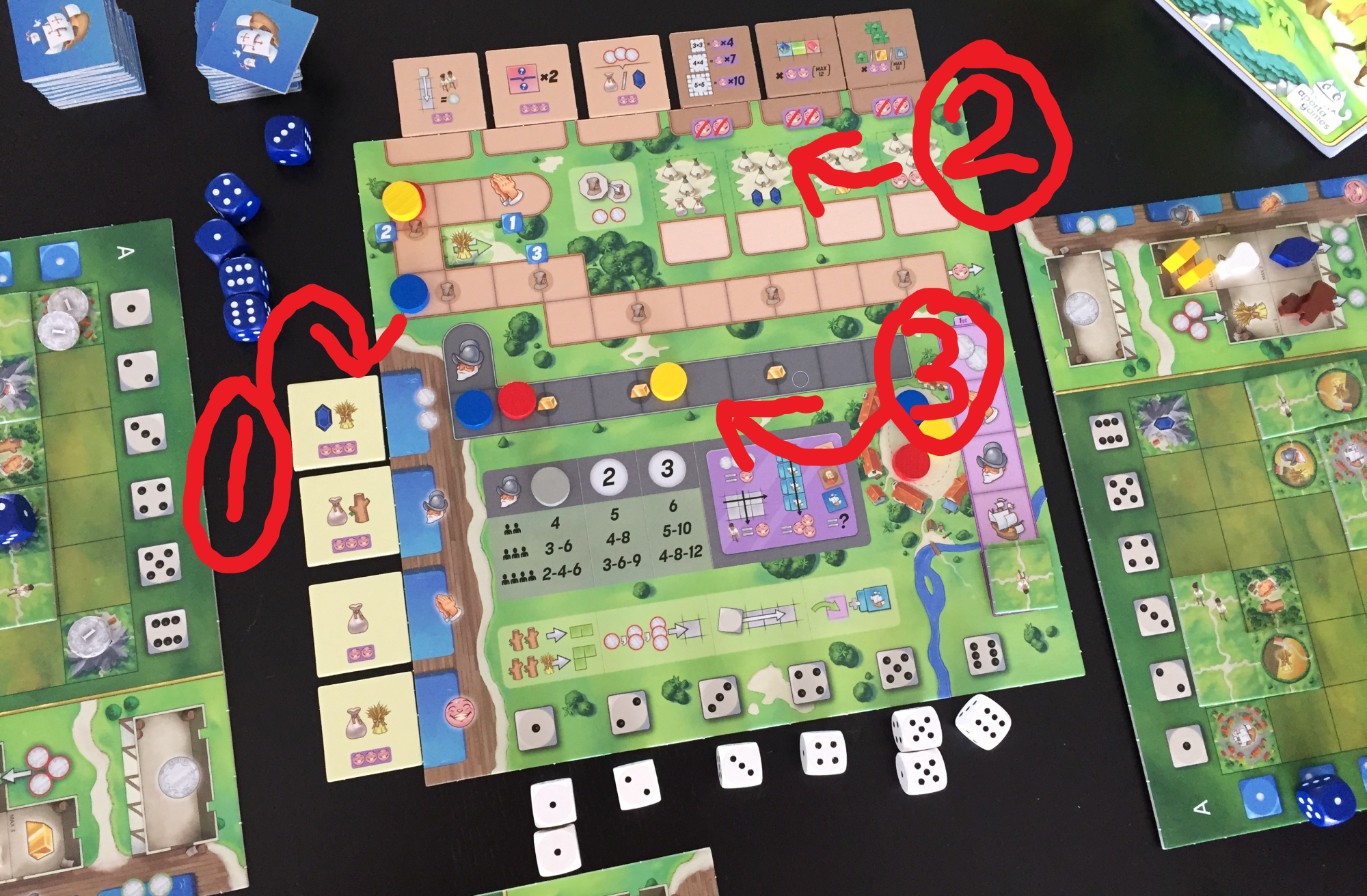
Quinns: BUT! Filling your warehouse to the eaves with sugar and jewels won’t actually win you the game. To get most of your Happiness Points you’ll need to take a stroll over to Santa Maria’s central board, which is like a point picnic, a happiness happy-hour, an Inflated Baby Buffet.
Why yes, I have been practicing my MS Paint skills. I’m flattered you noticed!
Over at (1) you can see the docks. By taking a dock action on your central board you can send your resources overseas, which gets you points, and depending on which dock you ship to you’ll then enjoy a free reward at the end of EVERY round, AND for every set of four ships you dispatch, you’re going to get even MORE points at the end of the game. Santa Maria is a VERY generous game, and inspires CAPITAL LETTERS in even the most JADED reviewer
Paul: Is (2) clapping? Do you go into the jungle and clap?
Quinns: NO. That’s the religion track. By taking a religion action you nudge your marker along this track, unlocking new workers but also unlocking monks that you can spend on immediate rewards, or special powers or point multipliers that are randomised before the game begins. Maybe you’ll get points for connecting roads to your capital city, or for placing tiles on your colony so they resemble a PERFECT, COMPLETED square. VARIETY, it’s the SPICE of LIFE
Paul: GOD, I love variety and also spice and… is that Santa Claus again?
Quinns: NO. (3) is the conquistador track.
Paul: But conquistadors are the OPPOSITE of Santa Claus.
Quinns: Yes! By taking a conquistador action you send soldiers out into the countryside to wrestle gold from the hands of the locals. Whoever’s furthest up the track will get a bushel of points each round, but the track also resets each round, so you only want to invest minimal effort into your soldiering. Tricky, tricky.
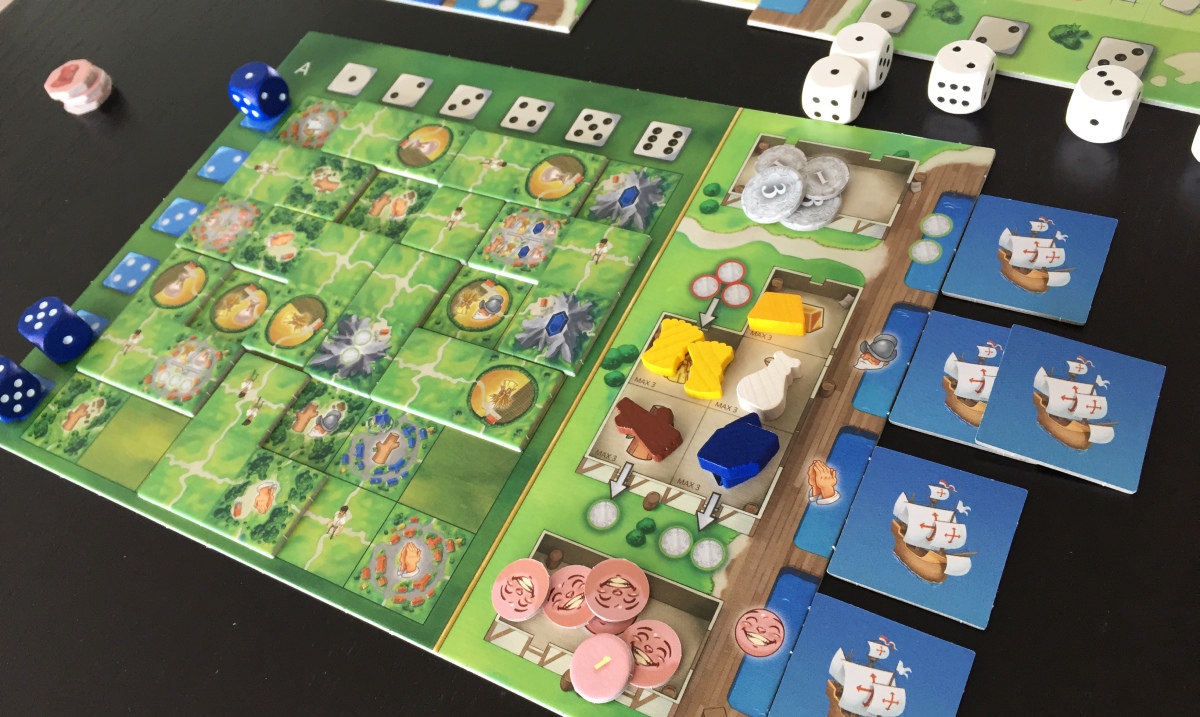
There are other ways to get points, but suffice to say Santa Maria is what the board game community calls a “Victory point salad”, a bunch of disconnected but crunchy ways to get points, until at the end of the game everyone regurgitates all of their swallowed and half-chewed plans in an confusing and often surprising final score. In a longer game this structure can be dissatisfying, but it’s quite at home in the game of Santa Maria. This is a breezy game that doesn’t want to trouble players with anything they MUST achieve.
There’s no secret behind Santa Maria’s success. To play Santa Maria – a nice idea with nice-enough art that placates players with a nice puzzle and nice rewards – is to have a lovely time.
Paul: I’d say it’s a little more than that. I’d say it’s a smart time. Every time I added more to my colony layout and found a new way to fire off my dice in an order that used some of the same spaces multiple times, that had the dice glide past one another without colliding like expert ice skaters, that had me trundle up the conquistador track AND the clapping track and ship just the right combination of resource to get myself another boatyboi, I felt good. Smart and good. And that feeling doesn’t fade each time. It’s the hit that keeps giving.

Quinns: Absolutely. This is a really good design. But – and I do this with the same dread that you might invoke Candyman – I think I need to echo the points that we made in our controversial Marco Polo review. Santa Maria is about as good as a board game can be without… filling me with any kind of… passion or desire? I’ve enjoyed all of the games of Santa Maria I’ve played, and I when I finish a game of it I often feel like I could play it again, right then and there! But whenever I pack it away I’m disinclined to take it off the shelf again.
Paul: Yep. Personally, I’d absolutely break out Santa Maria again, I think it presents some great mind-massaging challenges, I think it’s accessible without being easy and I think it’s a lot of fun.
Buuuuut I also think it fails to quite make the step up to greatness. It’s interesting and it’s satisfying, but it’s rarely exciting or exhilarating. It has so many neat little mechanics, but they don’t quite link together emphatically or really give you the sense that very much of what you’re doing affects other players.
AND everything about the art and design just makes me think of board games from… fifteen years ago. It looks a little too cute, a little too flat. Board games have come very far in their presentation over the last decade or so and everything about Santa Maria’s presentation feels like a peculiar prod from the past.
Quinns: Agreed. If you’re a fan of cute, flat puzzles with high rewards and low stakes, I’m sure you’d do alright buying Santa Maria and eagerly ogling the expansion that’s on the horizon. But there are so many similar games that I’d buy first- Azul, Isle of Skye, Castles of Burgundy, or the upcoming Lowlands (which we’ll be talking about on podcast #80).
And now we know how we feel about the game, let’s talk about the theme. Because holy crap this is a tonal mess.
So, at this year’s UK Games Expo you did an onstage interview with designer Martin Wallace (who, to be crystal clear, is NOT the designer of Santa Maria) and you two talked a bit about whitewashing, right? Do you fancy giving our audience a primer on what that is?
Paul: Sure! Martin closed the interview saying this was one of the things he found most objectionable in board games, and all media, and he was talking about the sidestepping of historical facts to paint a falsely innocent, far more placid picture of history.
This happens so often when we talk about colonialism and it’s exactly what’s happening with Santa Maria. We’ve got the cheery collection of natural resources and expansion of territory, without any acknowledgement of where those resources are coming from or who might live in that territory. Those bold and beardy conquistadors aren’t collecting gold by panning in a river, they’re literally beating it out of human beings to whom it has cultural and religious value.
Quinns: Yeah. I find absolutely bizarre how this game’s cover depicts brave-looking men and women blithely going about the business of construction. In reality, it’s unknown how many men, women and children the conquistadors massacred, but we do know of the inhumanity and rapacity they displayed, the wealth they amassed, even the torture methods they used on locals who refused to help them. To then have the currency in Santa Maria be “Happiness Points” with a picture of a smiling white person is just amazing.
We live in times when people all over the world are doing vitally important historical work unpicking the lies that have been taught to the descendants of colonisers. Speaking as an English person, it seems as though a new atrocity that we committed is being uncovered every week.
Nobody is saying that games can’t be about colonialism. But what Shut Up & Sit Down is saying, here and now, is that this kind of bumbling thoughtlessness is not good enough.
Santa Maria is not simply a game that’s disinterested in politics. Games like Santa Maria are intensely political, because, intentionally or not, they perpetuate a whitewashed view of the world. There’s a reason that Settlers of Catan is set on a fictional island, and it’s precisely to avoid having to do its due diligence. And that isn’t great, but it’s better than this.




